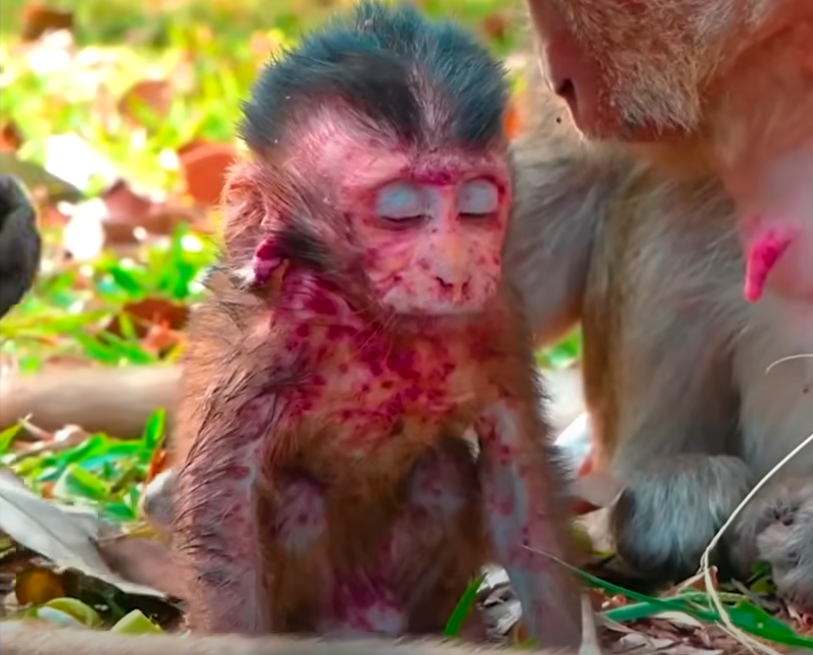In the heart of the ancient Angkor Wat forest, where the sun filters through age-old trees and the ruins whisper secrets of centuries past, a fragile baby monkey has captured the hearts of those who’ve seen her — not because of her playfulness or joy, but because of her pain.



Her name is MAI. Just a few weeks old, Mai should have been clinging joyfully to her mother’s chest, learning how to hop between branches, exploring a world full of life. Instead, she lies weak, her tiny body trembling, her skin marked with strange, raw patches that look almost burned. Her limbs twitch at times, and her eyes—those beautiful, glassy brown eyes—seem to plead for help, for comfort, for healing.
When we first saw Mai, it didn’t feel real. She looked unlike any other baby monkey in the troop. While others had soft, fluffy fur and pink, wrinkled fingers, Mai’s fur was thinning in patches. Her belly was swollen, and red spots dotted her back and face. Some of us thought she might have fallen into something toxic. Others feared it was worse — a rare jungle disease, perhaps even untreatable.
Her mother, a seasoned and loving monkey named Nari, never left her side. We watched as Nari gently groomed Mai’s patchy fur, whispering quiet grunts as if to reassure her baby that everything would be okay. But even Nari seemed confused. She would sniff her baby’s skin, look around frantically, and then curl her body around Mai to keep her warm and hidden.
There were moments that crushed us: Mai trying to stand, wobbling, and then collapsing. Nari nudging her, urging her to nurse, only to have Mai cry out in pain. Her cry — it wasn’t like the sharp, excited squeals of healthy baby monkeys. It was soft… hoarse… full of exhaustion. You could feel her suffering in every sound.
We tried our best to help — leaving clean water nearby, fruit just within reach. But Nari wouldn’t bring Mai near the rest of the troop, as if she feared others would reject her baby or worse — see her as a danger. In the wild, weakness can mean isolation. And yet, despite it all, Nari’s love stood like a wall against that.
Over time, some changes gave us hope. Mai’s appetite slowly returned. She would nibble tiny pieces of banana. Her eyes stayed open longer. We even saw her reach for a leaf — a small thing, yes, but it felt like a victory.
Still, her condition puzzled everyone. Some local forest caretakers suspected it could be a fungal infection. Others thought it might be a rare genetic disorder. Whatever it was, it didn’t change how we saw her: a brave little soul, fighting her own silent battle, wrapped in the love of her mother and the silent prayers of all who saw her.
Mai has become more than just a monkey with a strange disease. She’s a symbol — of resilience, of a mother’s unwavering love, and of the harsh but beautiful reality of life in Angkor Wat. Her journey reminds us that not every jungle tale is filled with carefree play. Some are about surviving, holding on, and hoping.
If you’ve ever felt helpless, scared, or different… maybe you’ll understand a bit of what little Mai feels. And maybe, just maybe, you’ll see how love — in any species — makes the difference between giving up and holding on.